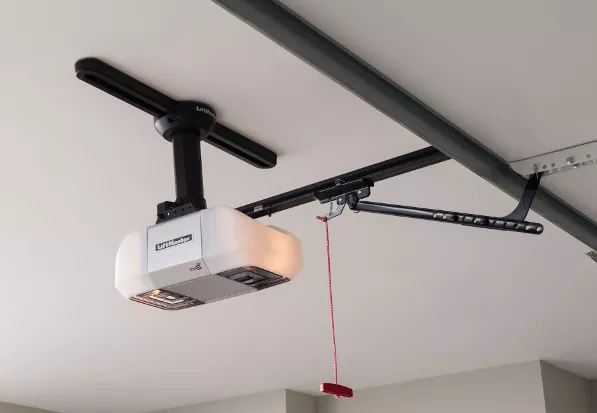
If you are thinking about upgrading from your old electric garage door opener to one that is a bit more modern and perhaps even quieter, you have options to consider. Many new garage door openers also come with smartphone connectivity and other technological advances.
Today, this blog will give you all the answers you need to choose the right motor size for your garage door opener.
Let’s get going by going over some simple background information
The absolute first thing you need to be aware of is that your electric garage door opener is responsible for making your life easier. It allows you to get inside your garage quickly and easily even when it’s a downpour and you want to avoid getting caught in the rain. However, that isn’t all that an opener does for you. It also lets you open and close the garage door with the strength of one hand manually, something you couldn’t do without it.
Wonder how this works? In order for it to work seamlessly, your garage door has to be appropriately balanced. This is done using a torsion or extension spring system, which is essentially a counterweight to the full weight of your door, which can be anywhere from 90 to 350 pounds (40 to 160 kilograms). When a garage door is balanced appropriately, it might feel as if it weighs no more than eight to 10 pounds (3 to 4 kilograms), which is a weight nearly anyone can lift with ease manually.
The next thing to know is how to determine whether your spring system is balanced or out of whack. In order to do so, you will want to close the garage door before disconnecting the garage door opener. At that point, you should manually open the door about four feet (1.2 meters) or halfway up. Assuming it is properly balanced, it will hang in that same position without any movement. If it shoots open on its own or falls quickly, you may have a spring system that is not working as it should be. If this is the case, you should immediately get in touch with Automated Door Systems to take care of the problem.
Your next question might be about whether a garage door opener is designed to lift a much larger load, up to around 225 pounds (100 kilograms). The answer is yes, but that also means that the motor can use that same amount of weight to push down. If you do not have a modern door opener with critical safety systems, objects or even people under a door that is closing could be crushed.
Word choice to be aware of
Reviewing a few terms is essential before we delve deeper into the idea of motor sizes for garage door openers. Many motorized products use something called horsepower, also referred to as HP in abbreviation. However, what you may not know is that there are actually two types of electrical current which can be used to connect to openers for your garage door. The most known is AC or alternating current while the other is DC, which is known as direct current.
When it comes to alternating current, it will be measured in horsepower. However, direct current is different and is measured in newton force or N. While these are two power types that are different, there are equivalencies available to compare the two power options.
Are you curious what the big difference is between the two? It’s simple. With AC-type motors, they run at the same speed at all times. DC motors, on the other hand, start slow, increase in speed, and finally reduce speed just before stopping. Your next question might be which is better. The truth is either is excellent in terms of performance, but a DC model is likely to be a bit quieter than an AC model.
Determining the ideal size of motor
Now that you are caught up on types of current, it’s worth looking at the motor sizes you’ll find on the market when it comes to residential door openers. If you’re going with an AC motor, you will find a range of 1/3, ½, and ¾ HP while DC motors are typically 500 or 700 newtons. As a point of comparison, a ¾ HP is the same as a 700 N motor.
When it comes to garage door openers for industrial and commercial buildings, the doors tend to be used more often and larger in size. Motors can be anywhere from ½ HP up to 5 HP. With residential garage door openers, the most common sizes are 500 N and ½ HP.
Based on all of those things, you may still be wondering what size is right for you? If you have a single door, which is typically 9 x 7 feet (2.7 x 2.1 meters), a 500 N or ½ HP motor is more than enough for your needs. Those who have double garage doors, which are about 16 x 7 feet (4.9 x 2.1 meters), you should choose a 700 N or ¾ HP motor. The same applies if you have a solid wood garage door.
Even knowing that, you also have to factor in how long the motor life is. Do you prefer one that will last seven years or one that lasts twice that time? If you are drawn toward a more expensive door opener, always be sure you have the price difference explained to you.
Finally, we come to the last factor to consider. Optional accessories available with a garage door opener such as remote light switches and garage door monitors may be something you want. If you go with one of the least expensive models, some of those accessories may not be available. This is why it’s crucial that you have your choices explained to you based on the manufacturing quality and motor size of the door opener.
Does connectivity matter to you?
Before you assume that you have chosen the perfect opener for your needs, you should be aware that nearly all modern door openers now come with built-in Wi-Fi connectivity or the option to adapt using optional accessories. This gives you the opportunity of controlling and monitoring your garage door from anywhere on earth, provided you have Internet access.
If you choose to meet a one of our garage professional, they can explain how these capabilities work. While you may think you have no use for them, the functions can be useful in the future. Keep in mind that some inexpensive options may not have all accessories you could want down the road.
Never ignore the importance of safety
If you want the safest garage door, and we assume you do, it needs to be adequately balanced, which means easily being able to lift it with a single hand. Below we’ll outline each step to evaluate your door:
- Yank on the red cord for emergency release to disengage your door opener.
- Use the lift handle on the second from the bottom or bottom section of the door to raise your door, bending your knees as you do so.
- Take the door up to about four feet or 1.2 meters and hold it to see if it remains stable at that height.
- Assuming everything goes as expected, back up the trolley that pulls the door to reengage the door opener and then use your remote to reconnect the system.
- If anything went wrong, speak to a GARAGE professional immediately who is knowledgable about garage door systems.
If you need additional guidance or information…
You can easily contact us. We would be delighted to go through your options in terms of electric garage door openers and help you find the one that best fits your budget and specific needs. We can also provide you with a quotation by email.
If you prefer, you are also welcome to visit us at our showroom. Those who end up choosing to replace their garage door can use our Design Centre to get an idea of which garage door style is right for your home. We also have an image gallery that can give you extra inspiration.



Add new comment